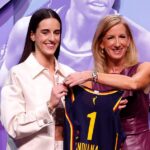Caitlin Clark, the No. 1 WNBA draft pick, has made millions this year as a college all-star thanks to several massive name, image and likeness deals, so when it became clear her rookie salary with the Indiana Fever would come in at $338,056 over four years, per the WNBA’s collective bargaining agreement, the internet exploded in an outcry over the gender inequality in professional athletes’ paychecks.
Over the next four years, Caitlin will be earning $76,535 her first year in the WNBA, $78,066 her second, and $85,873 her third, per NBC. She will also have the option to make $97,582 for a fourth year. By comparison, most men being drafted into the NBA can make eight-figure sums right off the bat. (For context, the highest-paid woman in the WNBA, makes less than $250,000, Axios reported).
But Caitlin’s not the only rookie making this salary: Other college heavy-weights like Stanford’s Cameron Brink, who was drafted to the Los Angeles Sparks, and South Carolina’s Kamilla Cardoso, who played at South Carolina and is headed to the Chicago Sky, are going to be cashing the same paycheck, NBC reported. And women’s basketball players and coaches alike are reminding folks to take a step back before talking about what an outrage this news is.
“Well it [the rookie salary] was even worse before,” says New York Liberty forward Breanna Stewart with a laugh. (Stewart was the No. 1 draft pick back in 2016 when she went to the Seattle Storm). Stewart says that the new salaries are a result of a new Collective Bargaining Agreement that “we were fighting hard to get,” adding, “we’ll continue to fight for it to be bigger and better each time, but it’s a process.”
Cheryl Reeve, USA women’s coach and president of basketball operations for the Minnesota Lynx also points out to those who are just now tuning in to the conversation that the league is still only 28 years old—and massive change takes time.
“Women’s sports are going to follow the same path as men’s sports,” she says. “If you look at the popularity of the WNBA versus the NBA at the same age, the trajectory of any sport that gets greater media coverage—that gets maybe a stadium built for them […] when you get the benefit of all those things—TV rights deals, etc.—you’re going to see a natural trajectory that all other major sports have enjoyed. And we’ll get our same opportunity for that.”
Of course, Caitlin and other new rookies’ star power as college athletes, with their own style, stories, and confidence, have certainly helped get more eyes on women’s basketball this year. And while that doesn’t automatically lead to paychecks that rival NBA salaries, it does pave the way for a new generation and culture around women’s professional sports.
“It’s been awesome to watch the evolution of the game. Obviously Caitlin’s been a huge part of that, but there’s other great players that helped with that as well,” says Jimmer Fredette, former college and pro basketball star, who is now on the Olympic men’s 3×3 team. “They’re just really excellent basketball players and very marketable and it’s been fun to watch.”
And as the women’s game continues to grow in new ways, “the salaries will obviously grow,” Fredette says.
In the meantime, these athletes can lean into other revenue streams like NIL and endorsement deals. As of Wednesday morning, Clark was nearing an eight-figure endorsement deal with Nike, according to The Athletic. And her brand new WNBA jersey is already the “top-earning jersey ever for a draft pick” on retailer Fanatics, per NBC.
“A lot of these girls are super marketable and they’re making a lot more money off the court than they are on the court,” Fredette says.
While it is certainly upsetting that male and female professional athletes have such vastly different salaries, Reeve points out that the fans are the ones who can actually help bring about change. “You play a part in it, right?” she says. “Obviously viewership, but sponsorship dollars, things like that, everyone plays a part in this.”
So, if these salaries make you angry, go buy those tickets. Order that Indiana Fever jersey. Tune in on game day. Only with support from fans—both financial and emotional—can the game and the women’s profits continue on their upward trajectories.
Currie Engel is the news and features editor at Women’s Health. She loves working on zeitgeisty news, culture, mental health, and reproductive rights stories. When she’s not editing stories, she’s writing them. Currie previously worked as an award-winning local reporter specializing in health investigations and features, and as a researcher at Time magazine.
Read the full article here




